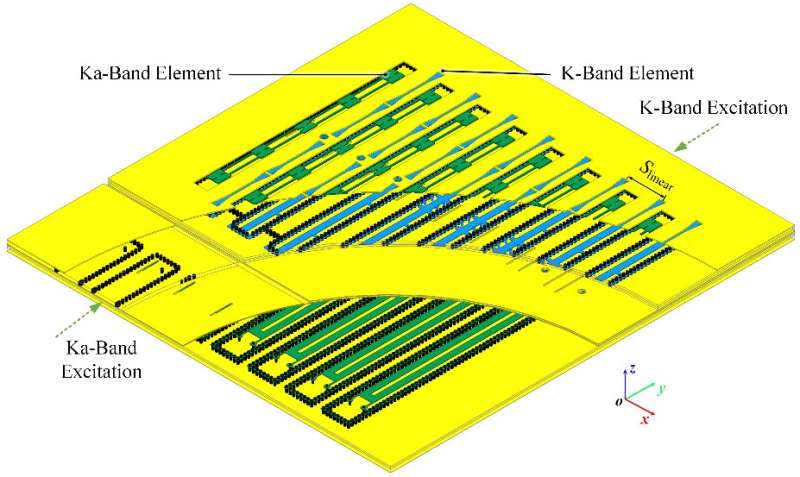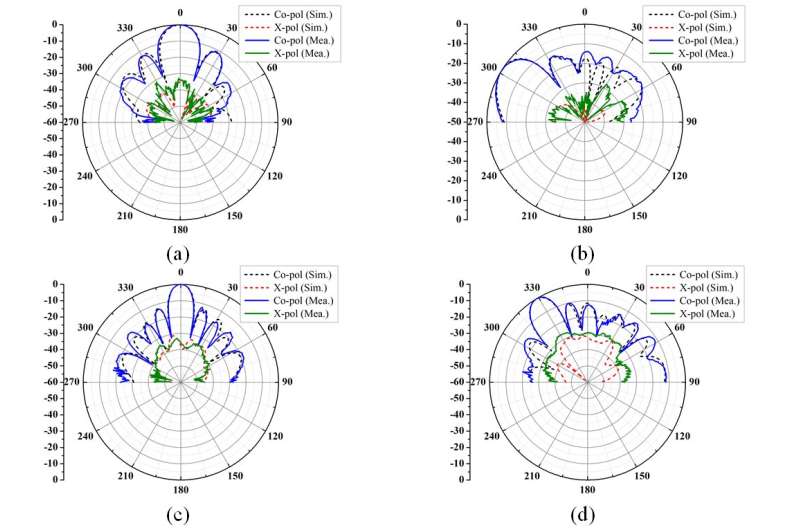This article has been reviewed according to Science X's editorial process and policies. Editors have highlighted the following attributes while ensuring the content's credibility:
fact-checked
trusted source
proofread
A K-/Ka-band planar shared-aperture beam-scanning array

With the rapid development of modern wireless systems such as radar and communications, there is an urgent need for the integrated development of multi-functional RF antennas. Since weight, size, and space placement are at a premium for these systems, it is desirable to combine the functionality of multiple systems into a single shared-aperture antenna.
The shared-aperture antenna has attracted considerable attention from the industry and academia due to its merits of high aperture usage efficiency, low cost, and multi-functional integration. Compared to the traditional two separated arrays with different frequencies, channel isolations have a pivotal role in the proper operation of shared-aperture antenna due to sharing the same physical aperture, because poor channel isolations can easily render the radio frequency (RF) chip self-excited or saturated.
Until now, most of the shared-aperture arrays reported in the open literature focus on the frequency band below the Ku-band, and only a few papers have reported mm-Wave shared-aperture array. However, as the operating frequency increases, the mutual coupling between the elements, the propagation of surface waves on the substrate, and the adoption of traditional microstrip feeding networks deteriorate the port-to-port isolation.
Therefore, the design of the shared-aperture beam-scanning array with wideband, outstanding isolation, planar, and lightweight become a tricky challenge.
To solve this problem, a K-/Ka-band planar co-polarized shared-aperture beam-scanning array is presented in this work. The substrate-integrated coaxial line (SICL)-excited short-circuited-stub-loaded longitudinal slot and substrate integrated double line (SIDL)-excited slot-loaded patches are employed to radiate K- and Ka-band waves, respectively.

Then, to constitute the 1D K- and Ka-band arrays, the center-fed SICL feed network and SIDL-based full differential feed network are introduced to widen the bandwidth. Those arrays are interleaved and shared the same radiation aperture, as well as the shielding metallic-via-array for achieving a compact footprint.
Both SICL and SIDL feed networks are located below the radiating aperture. In addition, the channel isolation is improved by utilizing the fully differential feed network and the filtering response of the SIW.
The proposed DBSAA is fabricated by utilizing the multi-layer printed circuited board technology to consolidate the previously mentioned design. Thanks to the miniaturized geometries of K- and Ka- band arrays, the proposed antenna is able to scan up to 60° and 35° at K- and Ka- bands, respectively.
The measured side-lobe levels are below -10dB in the principal plane of interest when the scanning angle is pointing to 60° and 35°. The measured S11 has a resonance at K-band with a -10dB valid bandwidth of 3GHz (17GHz ~ 20GHz). The Ka-band array obtains a -10dB impedance bandwidth of 12% (27.4GHz ~ 30.9GHz).
When the scanning angles are 0° and 60°, the measured channel isolation is larger than 35dB at K-band. When the beams are slanted at 0° and 35°, the Ka-band channel isolation is higher than 37dB. The measured results validate the design strategies and demonstrate the state-of-art performance in terms of bandwidth, isolation, profile height, and beam-scanning coverage, making it suitable for mm-Wave shared-aperture terminals.
The research is published in Science China Information Sciences.
More information: Zi-Jun Guo et al, A K-/Ka-band planar shared-aperture beam-scanning array with a high-isolation for the emerging mm-Wave shared-aperture terminals, Science China Information Sciences (2023). DOI: 10.1007/s11432-022-3587-8





















